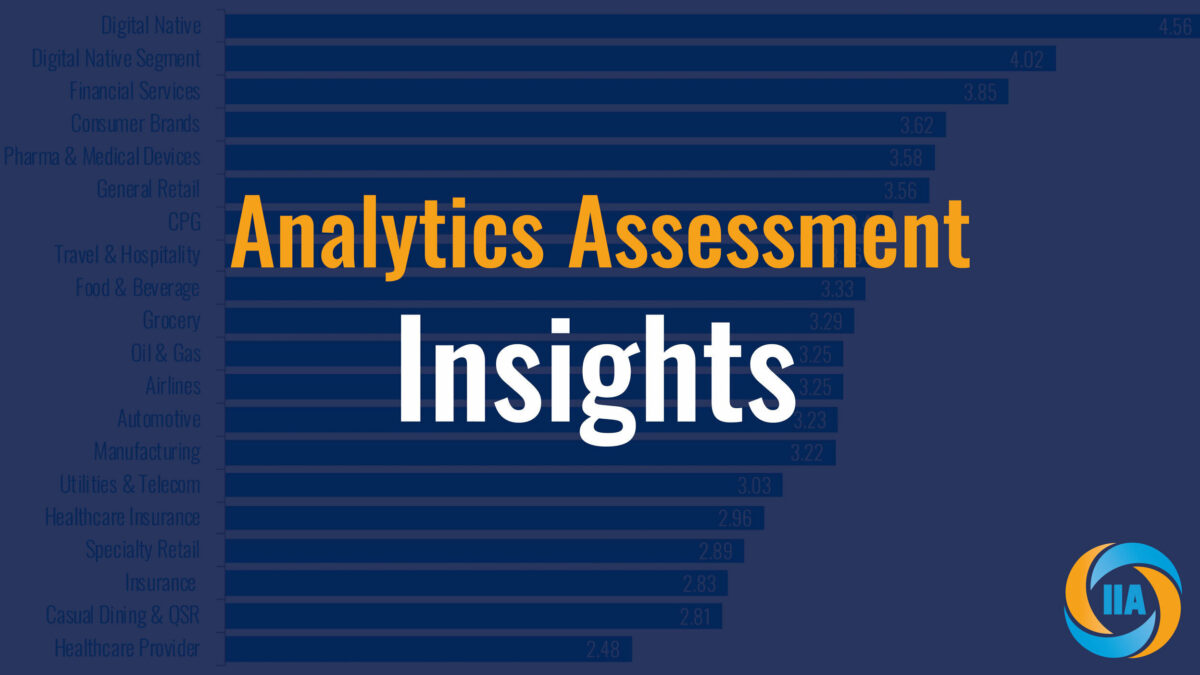
IIA has been performing analytics maturity and capability assessment for over five years. IIA’s analytics maturity assessment scores companies against the 5 Stages of Analytics Maturity originally introduced by Tom Davenport and Jeanne Harris in their book, “Competing on Analytics: The New Science of Winning.”
Over the past five years, we have gained a great deal of insight on the challenges most companies face in advancing analytics maturity, some of them quite unexpected. One of the most surprising is that many companies, despite a significant investment in budget and resources, seem to be stuck in Stage 2.
IIA’s DELTA Plus Primer describes Stage 2 as “Localized Analytics. Analytics or reporting at these companies exist within silos. There is no means or structure for collaborating across organizational units or functions in the use of analytics. This often leads to ‘multiple versions of the truth’ across a company.”
So, why is it so hard to advance beyond localized analytics? In our assessment work, we see six difficult-to-achieve milestones that must happen:
There must be a high-level executive(s) outside the analytics organization driving better use of analytics across the enterprise.
Enterprise stakeholders need to understand the difference between reporting/BI and advanced analytics.
There must be an effective data management and governance program in development that has been proved to work in an operational production environment.
There must be some consistency in how analytics are used by business stakeholders to drive business across the enterprise.
There must be some consistency in how analytics are developed and deployed across the enterprise.
The velocity of organizational improvement must be faster than general, marketplace advancements in analytics.
Sounds simple, right? Of course not. These changes generally require a cultural transformation beyond implementing new technology. Successfully transitioning out of Stage 2 can be greatly improved if analytics organizations adopt certain “philosophical approaches.”
Address your data issues
Fixing the data infrastructure is hard and painful. There are no quick fixes, and it often requires dedicated surge resources. We see many organizations essentially give up on fixing this problem because it is so hard. Instead, they try to advance their analytics capability and maturity in other ways. It will not happen. Analytics leaders need to focus their organizations to confront this issue, build good relationships with IT, and sell the business stakeholders on the absolute requirement to fix the issue and appropriately set their expectations on the pain and cost.
Focus on effectiveness
Too many organizations are focused on “checkbox” activities related to the drafting of processes, the completion of projects or the implementation of technologies. Unfortunately, many of these activities don’t get adopted by the enterprise and don’t result in business value. Items 3, 4 and 5 don’t require total success, but they do require real success on at least a limited basis. Organizations that view their internal business stakeholders as “customers” and that apply product thinking to their analytics activities become focused on effectiveness.
Create new customer-oriented roles
We have yet to assess a company that has over-invested in the training, communication and support resources required to roll out new platforms, approaches, etc. As analytics become more sophisticated, organizations need to expand the number of roles involved with actual implementation and rollout. For example, a software company selling an analytics solution generally has significantly more resources in roles like support, training, technical services, QA and deployment than it has actual development. Analytics organizations need to develop similar roles beyond analysts and data scientists to ensure successful adoption and deployment of their solutions. This may mean they need to do fewer projects in the near term, but real success in a handful of projects is better than superficial “checkbox” success in many projects.
Regular measurement
To advance analytics maturity, organizations generally have to increase their velocity. They have to get to better outcomes faster. There are a number of different processes (Agile, Lean, DevOps, etc.) being adopted to improve velocity. Frequent, annual measurements of effectiveness help provide the motivation to drive the cultural transformation needed to actually improve organization velocity.
If you are interested in learning more about advancing analytics maturity, Drew Smith and I recently hosted a webinar that touches on these topics (Becoming an Analytics Leader - 5 Things to Obsess About), and we have an e-book (5 Differentiators for Advancing Analytics Maturity) that outlines the organizational differences between the many companies in Stage 2 (Localized Analytics) and the few companies that make it to Stage 4 (Analytics Companies).
David Alles, vice president, has been with IIA for five years and leads IIA's assessment service line. IIA's family of assessments provides actionable, diagnostic insights and recommendations on analytics maturity, analytics capability and individual contributor skills. David has over two decades of executive, business strategy and product development experience with fast-growing technology companies and is a graduate from Carnegie Mellon University. (LinkedIn)